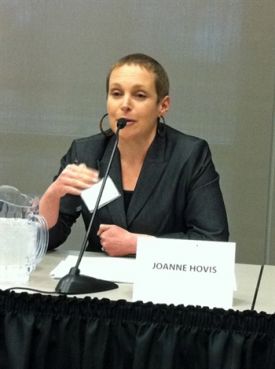
Fast, affordable Internet access for all.
Joanne Hovis, President of CTC Technology and Energy, recently published a must-read article in Broadband Properties Magazine. Whether you are a community leader investigating the possibility of a publicly owned network or an engaged citizen looking for pros and cons, this piece explains practical benefits succinctly. In her article, The Business Case For Government Fiber Networks [PDF], Hovis looks at life beyond stimulus funding. She points out how we should evaluate municipal networks in an environment where shareholder profit is not the first consideration.
Hovis gives a brief history of how local communities reached this point of need. As many of our readers know, local communities used to be able to negotiate with cable providers for franchise opportunities and rights-of-way. Often cable providers would construct broadband infrastructure in exchange for a franchise to operate in a given community, creating I-Nets for local government, schools and libraries. Once states inserted themselves into the process with state-wide franchising, local negotiating power evaporated. Many of those franchise agreements are ending and local leaders are considering municipal fiber optic networks.
Hovis stresses that municipalities do not function in the same environment as the private sector. While they still have a fiscal responsibility to their shareholders (the taxpayers) the main function is providing public safety, encouraging economic development, offering education, and using tax dollars to better the quality of life. Hovis describes how redefining return on investment (ROI) needs to go beyond the balance sheet bottom line.
These benefits have nothing to do with traditional financial measures. Rather, they represent the return to the community in terms of such largely intangible societal benefits as enhancing health care quality, narrowing the digital divide, providing enhanced educational opportunities to school children, delivering job search and placement opportunities at public computer centers and helping isolated senior citizens make virtual social connections.

Even without the intangible benefits, Hovis argues the financial benefits to local communities cannot be ignored:
First, a government network can help avoid existing and future costs by replacing services for which the government previously paid third parties. Second, a network can bring revenues to a community, especially given new E-Rate regulations that make government networks eligible for subsidy if they serve schools and libraries. Together, these cost savings and revenue streams can add up to significant dollars – potentially to amounts that justify financing the necessary construction.
Hovis explains the economics of government need to lease circuits, an extremely lucrative practice for phone companies or providers. In addition to being expensive, Hovis notes they are often low-bandwidth. Hovis takes it one step further:
Build the network and you will shave this amount from your accounts payable.
In fact, because a government network can deliver far higher-capacity connectivity than the jurisdiction had previously leased, its value is even greater than simple cost avoidance. A government that owns a network can use inexpensive, off-the-shelf equipment to connect its facilities to one another at no cost for bandwidth (because the traffic is “on network” and not going out to the Internet). It can also deliver Internet connections to these facilities at a per-unit cost much lower than that of leased connections because it can aggregate the needs of all departments and purchase commodity bandwidth. This is particularly true for a jurisdiction that can develop a mutually beneficial partnership with a provider of wholesale bandwidth.
Considering the fact that capacity needs continue to grow, savings with a publicly owned next-generation network increase exponentially. Eliminating the need to lease now eliminates the need to lease more later.
Hovis also examines in detail the different ways municipal networks can provide revenue. She examines:
The article also stresses one of the factors we find most compelling when considering investment in publicly owned networks - keeping local money in the local economy:
Circuits leased from a large national provider require the delivery of a big monthly check to a potentially far- away corporate entity, but monthly fees paid to a government-owned network stay in the community to be spent on other government services and to be multiplied when network employees go out to eat or spend money at other local businesses.
The concept of planning, financing, and building a municipal network is daunting to many communities; it should be a unique local decision. Few people have experience like Hovis, who does an excellent job of laying out critical considerations.
